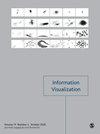Voronoi树图在曼哈顿距离和切比雪夫距离
IF 1.8
4区 计算机科学
Q3 COMPUTER SCIENCE, SOFTWARE ENGINEERING
引用次数: 1
摘要
基于欧几里得距离函数生成的普通Voronoi树图在可视化时变分层数据时具有略微调整布局的灵活性,以获得更好的视觉质量,保持邻域关系,并保持稳定的布局。然而,其由任意方向的片段形成的布局在不同时间索引的连续布局之间的形状稳定性较差,不利于用户理解情节和跟踪同一节点。在本文中,我们分别在曼哈顿距离和切比雪夫距离上提出了新的Voronoi树图,使得新布局中的线段只有四个方向(水平、垂直和与x轴±45°)。新的布局不仅可以继承普通Voronoi树图的功能,还可以保持良好的形状稳定性。为了实现这一点,我们首先关注曼哈顿距离内两个站点之间的加权平分线,并针对两个站点的不同权值设计了一种平分线生成方法,因为平分线是形成图表的基础。然后利用分治法将平分线形成Voronoi图,并利用Lloyd方法迭代调整图,最终得到Voronoi树图布局。此外,我们证明了曼哈顿距离的树图算法可以通过线性变换调整为切比雪夫距离的Voronoi树图,从而避免了设计额外的算法。首先评估所提出方法的计算特性,以检查布局是否能够快速准确地生成。然后分别基于质量度量和用户研究对感知特性进行定量和定性评估。结果表明,与普通的Voronoi树图相比,所提出的Voronai树图保持了相似的布局稳定性,但具有更好的视觉质量和形状稳定性。我们的算法简单且与分辨率无关,但也提供了Voronoi树图的替代方案。本文章由计算机程序翻译,如有差异,请以英文原文为准。
Voronoi treemap in Manhattan distance and Chebyshev distance
The ordinary Voronoi treemap generated based on the Euclidean distance function has the flexibility to slightly adjust the layout when visualizing time-varying hierarchical data for better visual quality, preserving neighborhood relationships, and preserving a stable layout. However, its layout formed by segments with arbitrary orientations has poor shape stability between successive layouts at different time indexes, which is not conducive for the users to understand the plot and track the same node. In this paper, we propose novel Voronoi treemaps in Manhattan distance and Chebyshev distance respectively, such that the segments in the new layouts only have four orientations (horizontal, vertical, and ±45° to the x -axis). The new layouts can not only heritage the abilities of ordinary Voronoi treemap, but preserve good shape stability. To achieve this, we first focus on the weighted bisector between two sites in Manhattan distance and design a bisector generation method for different weight values of two sites, as the bisector is the foundation to form a diagram. Then a divide-and-conquer method is utilized to form the bisectors into a Voronoi diagram, and a Voronoi treemap layout can be finally obtained by using Lloyd’s method to iteratively adjust the diagram. Moreover, we prove that the treemap algorithm in Manhattan distance can be adjusted to also generate the Voronoi treemap in Chebyshev distance via linear transformation, avoiding designing additional algorithm. The computational properties of the proposed methods are first evaluated to check whether the layouts can be generated fast and accurately. Then the perceptual properties are evaluated quantitatively and qualitatively based on quality metrics and user studies, respectively. The results demonstrate that the proposed Voronoi treemaps preserve similar layout stability, but better visual quality and shape stability than the ordinary Voronoi treemap. Our algorithms are simple and resolution-independent, but also provide alternatives to the Voronoi treemaps.
求助全文
通过发布文献求助,成功后即可免费获取论文全文。
去求助
来源期刊

Information Visualization
COMPUTER SCIENCE, SOFTWARE ENGINEERING-
CiteScore
5.40
自引率
0.00%
发文量
16
审稿时长
>12 weeks
期刊介绍:
Information Visualization is essential reading for researchers and practitioners of information visualization and is of interest to computer scientists and data analysts working on related specialisms. This journal is an international, peer-reviewed journal publishing articles on fundamental research and applications of information visualization. The journal acts as a dedicated forum for the theories, methodologies, techniques and evaluations of information visualization and its applications.
The journal is a core vehicle for developing a generic research agenda for the field by identifying and developing the unique and significant aspects of information visualization. Emphasis is placed on interdisciplinary material and on the close connection between theory and practice.
This journal is a member of the Committee on Publication Ethics (COPE).
 求助内容:
求助内容: 应助结果提醒方式:
应助结果提醒方式:


